It is said history repeats itself and it is no different for fashion! Indian fashion is as ancient as the human civilization with a mix of regional, cultural and historical influences. The fashion in India or anywhere else in the world always repeats itself in a decade or two bringing neoteric twists to the current fashion. Our generation is influenced by the world of fashion so much so that it has become as essential as food and water. And mind it, it is not just wearing clothes we are talking about but the ever evolving and changing fashion trends which we love to incorporate into our wardrobes. What all led to this? What are major influences? How does current fashion differ from ancient Indian fashion? What is the history of fashion in India? It is imperative we know what we wear a little more in detail!
FASHION IN ANCIENT INDIA
Fashion somewhere started showing its colors from the times of ancient India itself. There is some evidence of Indus Valley Civilization or Harappa civilization indicating the use of woven cotton fabric. Flax plant was grown to obtain the fibers of plants and silkworms were cultivated for silk. The priest-kings wore a robe over their shoulders and men wore turban draped over the head. The style of women’s clothing included knee-length skirts with jewelry like bangles, earrings, and beaded necklaces. Even men wore jewelry and all this data is as per the figurines obtained from excavations. One of the first pieces of evidence of Dhokra art which is quite popular now is the dancing girl of Mohenjo- Daro.
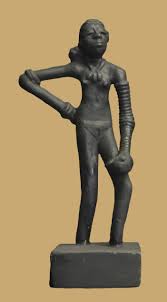
The Vedic Era
During the Vedic era, a single cloth draped around the body, across the shoulder was pinned or fastened with a belt and was considered a comfortable attire for hot weather. Paridhana or vasana was a lower garment which was a cloth draped around the waist with a string or belt called as rasana or mekhala. A shawl-like garment worn over the shoulder was called as uttaiya. Pravara, a third garment was like a cloak mostly worn in cold months. This was a general dressing for both men and women, which only varied in the style of wearing and size. When stitching started during the Vedic period, for women saree was the easiest attire to wear. Later on, a blouse or choli was also incorporated to cover the upper part of the body. Ghagra choli and dupatta were also introduced later during the Vedic period. Some of the sculptures revealed the used of cloth on the lower body which was pleated in front and held with the help of a long girdle. The girdle at time appeared to the end of the cloth, this might have been a trailblazer to the modern saree. Vedic men were also known to wear dhotis which draped around the waist and separated with pleats. No upper garments were worn by men during the Vedic era.
Post-Vedic Era – The Time of Dynasties
Post-Vedic era, many dynasties came and ruled like Mauryas, Sungas, Guptas and Kushans. Fabrics like wool, silk, cotton, jute, linen, and muslin were used widely for making clothes. In Maurya and Sunga dynasty, women wore antariya in different styles. Antariya was a small strip of cloth and further, a langoti was fastened to the kayabandh at the center and passed between legs from front to back and tucked behind. There were many other styles of wearing antariya. Antariya were initially opaque and gradually became transparent over a period of time. The fabric used for antariya was linen, white cotton, muslin and even embroidered with precious stones and gold at times. Men draped antariya around the hips and between their legs, it extended from waist till calf or ankles.
Headgears and head wraps were a distinct style of women clothing in most of the dynasties. Women and men both wore jewelry and head wraps. Women donned jewelry like layered necklaces, earrings, armlets, and baju-band to name a few.
The process of weaving was well-known during that era. Furs and various varieties of wool and tassar, eri silk and Muga silk were also used. Fine embroidered muslin cloth in gold and purple colors in a transparent material called shabnam was also used. Dyeing of textiles was well-established by this time.
After the age of dynasties came the time of royalty or kings which has a major influence on fashion even today owing to the fine and exquisite craftsmanship used during those times.
THE ROYALTY OF KINGS
When we look back at the glorious centuries of kings and queens, flashes visions of beautiful palaces and forts, fine arts and music, lavish food and of course extraordinary clothing and fashion. India has seen many dynasties and rulers and every kingdom, be it Mughals, Marathas, Scindia dynasty or Rajputana rulers, brought a distinct quality and influence to ancient Indian fashion. Till date, many royal families have kept their heritage intact with their style of dressing and traditions. With the finest craftsmanship on clothing and ultimate finesse in textiles, they are the reason the history of fashion in India is so rich and memorable. Indian designers often take inspiration by the royal dressing of various regions or dig through the archives to draw inspiration from ancient Indian fashion.
The Wadiyars
Wadiyar dynasty ruled the Kingdom of Mysore from 1399-1950. The word Wadiyar means the Lordship. During the rule of Wadiyars, special traditional attire called the Durbaar dress was donned by every person who had an appointment with the king at Durbaar. The attire was meant to show the social hierarchy and status of the person in comparison to other sections of the society. Men wore traditional attire which included a black below knee length coat along with white churidaar pants. The turbans were draped with a golden lace known as Mysore Peta. Another attire, which included a dhoti, beautifully adorned with delicate gold zari embroidery at the border was draped by men around the waist which looked equally royal. The women wore rich pure silk sarees decorated with gold and silk thread embroideries. The styles of Wadiyars is still an influence on men’s fashion especially in wedding wear which includes churidaar pants with long kurta for dapper Indian style. Embroidered silk sarees are a major fashion influence loved by women all across the country.
The Royals of Udaipur
Royal rulers or kings of Udaipur belong to Mewar dynasty. Udaipur, the beautiful city of lakes is a home to many royal families and rich legacy. The splendor of Udaipur Maharanas is depicted by the Rajasthani royal paintings. One of the essential accessory to showcase their royalty is a parasol or chattri called Kirnia. Maharanas of Udaipur style of dressing over a period of time got influenced by European dressing; they wear bandh galas with western style jewelry. The occasional dressing of former Maharanas included a traditional royal garment which included a turban or pagdi with a long sarpech embellished tail, long and flowy achkans with churidar pants and a sash across the body and a belt or a kamar bandh around the waist. A sheathed sword is another important element of their grandeur dressing which symbolizes power and patriotism. Maharanas have a profound love for fine jewels and have exquisite pieces in their heritage collection designed by French jewelers. The royal rides like elephants horses are also decorated with clothing embellished with gemstones.
Nizam of Hyderabad
Also known as Nizam-ul-Mulk of Hyderabad, Nizam of Hyderabad was a monarch of the state of Hyderabad. The very first Nizam is known to rule on the behalf of the Mughal kings. They ruled Hyderabad with immense power till 17th September 1948 when Hyderabad was combined into the new Indian union. Nizams were hugely fond of fine arts, culture, and literature. Nizam jewelry is world famous and one of a kind and Nizams loved to flaunt them with pride. Fine jewelry adorned with pearls and exquisite gemstones is one of the signature designs of Nizam jewelry. The Nizams wore sherwani with a turban embellished with a sarpech. Nizam jewelry has a huge influence on Indian ethnic jewelry; wedding jewelry specially made with precious gemstones and pearls is inspired by Nizam.
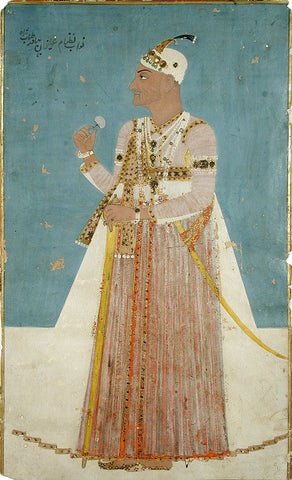
The Tale of Maharani of Kapurthala
Believe us, when we say her story was no less than a dream we mean it! A fairytale story of a Spanish woman who became Indian queen! What is more interesting, is her fine taste for Indian clothing and style which made her one of the most iconic Indian queens. Maharani of Kapurthala’s wedding lehenga was pink with fine silver and gold embroidery and her look was further elaborated with rich jewelry, these are shreds of evidence found in her personal diary. Her sarees and jewelry showed her luxurious lifestyle and taste. The saris were mostly of deep rich colors including pinks, maroons, and reds. They were embellished with brocade embroidery or gold zari which showed her opulent style. The sarees were draped over the head like a pallu which depicted a perfect picture of a Maharani. Maharani also wore beautiful long pure silk gowns with an off shoulder design which flaunted her Victorian style in an Indian setting. Her collection of jewelry included exceptional pieces adorned with fine gemstones like emeralds, rubies, and diamonds. She wore heavy necklaces, earrings, and bracelets which showed her royal side perfectly. Her jewelry collection was auctioned in 2007 in London.
The Holkars of Indore
Holkars come from Holkar dynasty which was a Hindu Maratha royal house in India. They ruled as Maratha kings or Rajas and later they ruled as Maharajas of Indore in Central India. The Holkar kingdom later became a princely state under the protectorate of British India. The Holkar dynasty was founded by Malhar Rao who was a Maratha chief serving under Peshwa Baji Rao. They are known around the globe for their collection of finest jewels and jewelry. It is believed Maharajas entire collection of jewelry between 1930 and 1940 was worth 40 million dollars. Famous French jewelers like Chaumet, Van Clef and many more crafted and designed fine jewelry pieces for Majaraja Yashwant Rao. Richard Sivaji Rao Holkar and his American wife Sally revived beautiful Maheshwari saris. The occasional dressing of Holkars kings included angas, turban or pagdi, sheathed sword, and fine jewelry pieces. The Holkars queen wore rich Maheshwari sarees with jewelry in their regular life.
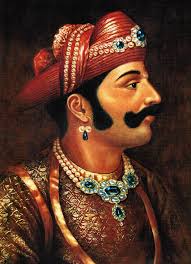
Maharaja Gaekwad of Baroda
Gaekwads began ruling Baroda when Pilaji Rao Gaekwad, a Maratha general took over the city in 1721 from the Mughals. Gaekwad is a Hindu Maratha clan and Maharaja Gaekwad of Baroda was the ruling prince. During the British rule, it was one of the wealthiest states with a flourishing business of cotton, rice, sugar, and wheat. Post Independence, Baroda became a city of Maharashtra. Gaekwads were known to be very traditional pertaining to their customs and culture. Laxmi Vilas Palace the most opulent and grand palace of Baroda was made for the newly married Maharani and Maharaja. Gaekwads had a love for everything rich and grand, right from the decorated rides like elephants and horses to the finely embellished carriages. They wore long fine silk robes, exquisite turbans, fine jewels and swords encrusted with jewels which were a sheer symbol of bravery. Gaekwads were extremely fond of pearls and the same can be seen in several paintings which show Maharajas wearing heavy strings of pearls and gemstones. Maharaja wore opulent clothing with fine jewels as he was regarded as a deity by his subjects. Maharaja Gaekwad used to wear neatly tied small turbans which were made from a fabric woven in centers of Western India. Purple or gold colors on a white or yellow background were used for turbans. Maharaja wore robes embellished with sequins and finished with silk piping. Another traditional dress called Angrakha was a robe worn by men. During the British Raj, Maharaja also wore western attires and adopted Western style and mannerism.
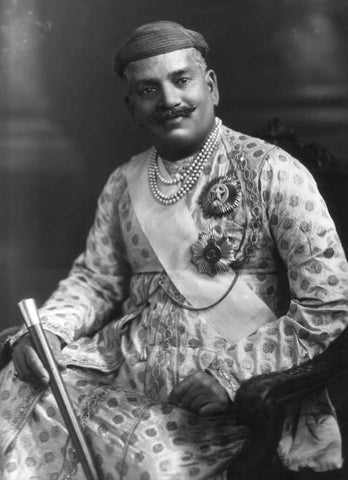
Scindias of Gwalior
Another known Hindu Maratha clan is Scindia or Shinde which ruled the state of Gwalior. The dynasty was founded by Ranoji Scindia, son of Jankojirao Scindia. The Scindians wear a trademark dress over their heads which is donned only by the members of the royal family on special occasions. In 16th and 17th century, men wore a traditional Anga, a brocade and silk kurta which gave the appearance of a coat along with a sheathed sword and a pagdi to finish off the royal look. This was the key look for formal occasions or festivities. The women wore fine silk sarees draped in traditional Marathi style along with finely crafted jewelry. Maharaja of Gwalior wears a distinct style of pagdi in form of a boat called Shindeshahi Pagdi which sets the Royals apart from the rest.
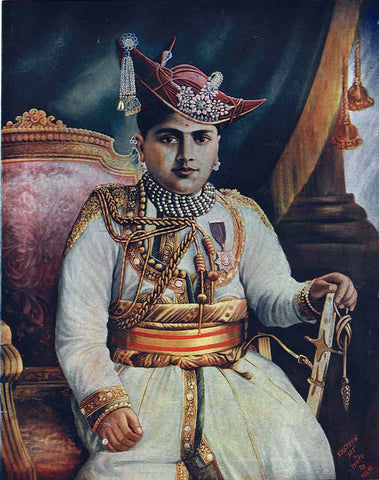
Maharawat of Partabgarh
The Pratapgarh or Partapgarh region of Rajasthan is known for the royal family of Partagarh created by Rawat Suraj Mal. The region is known for its fine handicrafts items and the royals of the Pratagarh are known for their fine and exquisite dressing. The attires are created from the finest of woven silk and cotton for the Royals. Maharawat of Partapgarh was known to be a patron of Thewa jewelry, a form of jewelry making where beautiful intricate designs of gold were carved on the colored glass which is popular to date. He was extremely fond of rich woven silk and cotton fabrics. Maharawat used to wear turban embellished with precious stones like rubies, diamonds and pearls and further to enhance his royal persona a peacock feather was added to the turban. His royal robe was made from fine zari made from gold threads. The dressing sense of royal men of Partapgarh has undergone many changes due to the foreign influence. They switched to trousers and linen shirts from dhoti and turban for comfort and adapting to a new lifestyle.
Maharao of Bundi
Bundi is a region located in Rajasthan and the Maharaja or King of the region is addressed with the word Maharao. The place is now a known tourist destination owing to the architectural legacy left by the Maharao of Bundi. They were an ardent supporter of arts and architecture in the region and the architecture had a Mughal influence which was seen in their palaces and forts. Raja Rao Raghubir of Bundi had an opulent style of living and one of his paintings depicted his grandeur. Dressed in a fine silk robe with a bejeweled turban, fine diamond necklaces, a sheathed sword and a distinct style of beard, his persona depicts every bit of a royal he was. Due to the British influence, Maharaos started dressing informally or in Indo-western attires and overall a major change of lifestyle came in Maharaos living.
Maharaja of Travancore
One of the modest royal families to rule a region of India is the royal family of Travancore. The Maharajas of Travancore lived a life which was nothing close to being lavish and opulent kinds. They have devoted their lives to the welfare of people and spend very less on themselves from the state’s resources. The simplicity was depicted in their simple style of dressing. The queens used to wear Mundu sarees similar to the Kasavu sarees of Kerala in cream or white color with gold detailing.
The Finery of Mughal fashion
Mughals have left a strong impression on craftsmanship in India. Their fine artistry and workmanship is absolutely unparalleled. Be it clothing or architecture their taste for every magnificent is easily reflected by the finery of designs. Attires created from luxurious silk, velvet, brocade and muslin and elaborate designs and embroideries were the distinct characteristics of the Mughal fashion. Men wore exquisite design short and long robes or coats which included long-sleeved clothing called chogha. Pagri on the head, a patka or sash at the waist, pyjama style pants were trademarks of men’s fashion. Their turbans were usually adorned with fine jewels or precious stones like diamonds, pearls and rubies.
Women, on the other hand, wore a traditional dress of Persia and Khurasan due to Purdah system. In the court of Humayun and Babar, most noble women wore loose wide pants. The upper body garment was loose which was fastened with a V neckline. When Rajput princess entered the Mughal kingdom, the influence of Hindu clothing could be seen in the court. Usually, the clothing was changed often in the zenana during a day and was worn only once and then given away. Garments were made from thin cloth almost transparent with a gold lace. Turbans made with gold cloth and a feather covered the head. Kashmiri shawls were popularly used in the cold season. Bejeweled and patterned shoes with curly pointy tip were also worn by women.
Women and men wore opulent fine jewelry with precious stones which were a fine example of Mughal craftsmanship which is documented from the paintings. Women wore 8 complete sets of jewellery included bejeweled turbans, earrings, pearls necklaces, armlets, bangles & bracelets, rings, thumb ring, string of pearls or metal bands as anklets and head ornaments in the form of sun, moon, stars or flowers. Various types of ear ornaments were worn during the Mughal period which included Jhumkas, Kanphool, Bali, Mor-Bhanwar and Pipal Patra.
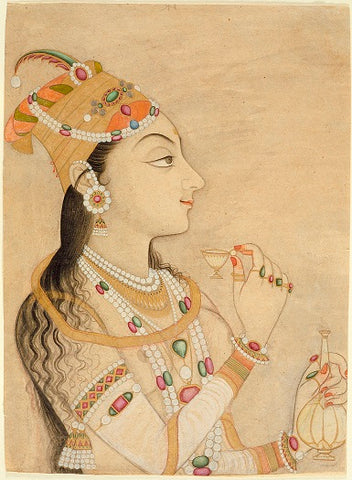
The use of costly forms of silk, wool, and cotton was profound in the clothing. Other fabrics which were also used during those times included light and warm wool, pashmina, tush or tus. Silk fabrics were beautifully embroidered with silver and gold threads. Shawls made were so fine and thin that they could easily pass through a ring.
Mughal Emperor Akhbar
The great Akhbar who was the third Mughal Emperor ruled between 1556 and 1605. He had a strong personality and a powerful influence over the country. Akhbar was a patron of culture and arts and supported Hindu-Muslim unity. He had a distinct style of dressing which included comfortable clothing. He was extremely fond of shawls especially the Dorukha shawl, a double-sided variety of shawl. Though he was simple in thoughts, his style of dressing included a gemstone embellished small turban, a long kurta layered with a jacket which is still an inspiration for Sherwani designs. He also wore fine jewelry which included pearls strings, emerald embellished waistband, and heavy rings which perfectly elevated his royal figure. His clothing was always embroidered with intricate Kundan and zari work reflecting his opulent life.
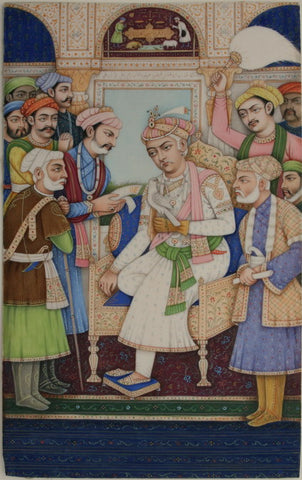
Maharani Jodha
If you want to have a glimpse of how regal and opulent was the dressing style of Maharani Jodha, then you must watch Bollywood movie, Jodha Akhbar. A beautiful Rajput princess marries a Mughal Emperor Akhbar as a part of an alliance. Her dressing style was not of any ordinary queen. Immersed in richly embroidered woven fabrics made in Rajasthan, she did every bit of justice to the word queen. The fine craftsmanship done on the fabrics with zardozi, kundan and stones to create her royal attires like lehenga choli was nothing like anyone has seen till date. The attires were created with finest brocade, silks and cottons in bright and vibrant colors. Her head was mostly covered with dupatta or a pallu. When coming to her jewels, it was worth every stare! Royalty exuded through her fine jewelry made from polki, kundan and fine jadau work. Heavy necklaces, earrings, hand harness, math borla, waistband, armlet and what not. She was a moving art drenched in tradition. Jodha’s style of dressing has inspired current bridal fashion in India. Royal looks of brides are immensely inspired by Jodha’s jewelry and lehengas.
CHARKHA - A FASHION REVOLUTION
The revolution created by Mahatma Gandhi’s Charkha is not only historical but also a major landmark in changing the scene of fashion in India. Khadi which became a symbol of patriotism during the Swadeshi movement to drive away all the foreign material used in India for clothing is today a proud symbol of Indian textiles. It is used in many forms like in Khadi sarees, suits, kurta pyjama and much more. The earthy feel of fabric woven on a spinning charkha in the rural areas of the country is a source of employment for many and is being continually used in ethnic Indian fashion.
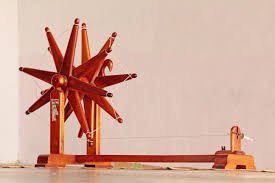
PARDA SYSTEM
Purda or Parda system has been practiced since ages in India in Hindu and Muslim communities. It is a social and religious practice for segregating the sexes women from men basically. This practice secludes women and also restricts their personal rights and choices. It is also a believed it is a form of respect and to conceal female body parts. In the Hindu community it is called Purdah and in the Muslim community, it called Burqa or Naqab or Hijab. It is especially important for married Hindu women to keep a purdah or veil or ghunghat in front of the elder men or outsiders. The pardah is a part of the saree pallu draped over the head to cover the entire face.
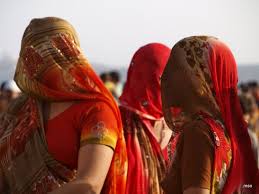
In Muslims, the practice is still very prevalent around the world and is an important part of their religion. Women generally wear a black burqa as an external black robe to cover themselves from head to toe with a mesh across the eyes. It is believed to protect the women’s honor. Hijaab is another form of veil worn by Muslim women which usually covers head and chest in front of adult males or outsiders.

In Hindus, the practice is diminishing with modernization but is still prevalent in the rural areas of India.
FASHION EVOLUTION IN INDIA
The history of fashion in India has evolved and left its mark all over the world. Today, Indian fashion is a force to reckon with, with a rich historical background. Our woven handloom textiles, beautiful sarees, party dresses, designer dresses, rich embroideries have turned Indian fashion platter into a gamut of rich diversity. The regional diversity in weaving, embroidery and clothing styles has made Indian textiles all the more vibrant and appealing. Indian designers have played a major role in making the fashion world what it is today! The fashion industry is still evolving and emerging in the country with a major emphasis on sustainable and eco-friendly fashion. Let us look at how the fashion has evolved over a period of time.
Post- Independence Scenario
Though the fashion history of India can be dated back to ancient times, it was post-independence that fashion industry saw a major growth and evolution. Saree, dhoti, ghagra choli remained quite popular in the pre and post-independence era. But with the influence of Western culture, many changes made a foray in the Indian fashion scenario. Embroidery is a common point between Indian and western fashion and is also a trademark of Indian fashion which is vastly used on silhouettes like sarees, lehengas, suits and many other attires. The same embroidery became a fashion statement when it started emerging on Western attires like shirts, skirts, dresses and more which made a good amalgamation of Indian and Western style.
Indian Fashion Designers like Ritu Kumar started the revival of hand-block printing in Bengal. She also brought the beautiful craftsmanship of Zardozi to limelight in the 70s which revived this art. Embroidery became an important mark of Indian fashion, especially in Indian bridal clothes, which made embroidery India’s biggest fashion export. Other forms of weaving, embroidery, and printing like patola ikat, double ikat, and ikat, tie-dye also were revived with the efforts of many NGOs.
Bollywood Influence
Meanwhile, as the fashion industry was taking small steps, Indian movie Industry or Bollywood was growing by leaps and bounds. The influence of Bollywood dressing on fashion is massive to date, and every decade presents a different Bollywood fashion which becomes a favorite amongst the masses. During the 50s, the influence of British fashion could be seen in movies where actress wore elaborate gowns with curled hair. Sarees with short fitted blouses and big hair buns was also a popular fashion during the era. In the 60s, designer Bhanu Athaiya started her experiment with fashion. Movies like Amrapali and Sahib, Biwi Aur Ghulam showed a side of the period and traditional costumes. It was a period when bright colored sarees became a favorite of women draped in a spiral shape as seen on Mumtaz in the film Brahmachari.
Further, many western fashion trends became a part of Indian movies like Chalte Chalte, Hare Rama Hare Krishna, Karz and many more in the 70s with flared bell-bottoms, big sunglasses, bow-tie shirts and wavy hairdos. The 80s was a period of flowy chiffon sarees as seen in movies like Chandni and Mr.India on Sridevi which exuded sensuality and grace at the same time. Bright color lip shades and loads of kajal and mascara were makeup essentials during the decade. In fact, the western style of wearing shoulder pads with dresses became a style statement in Indian Salwar suits. This style was popularly seen on Rekha in Khoon Bhari Maang and on Dimple Kapadia in some movies.
The most iconic movies of all the times which made a strong impression on Indian fashion were made in the 90s. Movies like Hum Aapke Hain Kaun, Dilwali Dulhania Le Jayenge, Dil to Paagal Hai, Kuch Kuch Hota Hai brought a distinct flavor to the fashion scene in India. Remember Madhuri’s backless saree blouse paired with embroidered saree and exquisite green and white lehenga choli in the movie Hum Aapke Hain Kaun that became a wedding fashion rage in the country! Kajol’s iconic wavy hair with sunglasses and midi dress was a girl next door look which young girls loved to don on a daily basis. Dil to Paagal hai brought a new style of sheer panel churidaar suits perfect to channelize your feminine side.
From the 2000s onwards fashion saw a major change with Anarkali suits and designer sarees a must-have in every Bollywood movie. Movies like Devdas, Kal Ho Na Ho, Bunty and Babli and many more again created major fashion statements in the country. From Aishwarya’s heavy embroidered Bengali sarees in Devdas to Preity Zinta geek chic look in Kal Ho Na Ho to Rani Mukherjee’s collared salwar suits in Bunty and Babli every style influenced women’s fashion choices. Till date, Bollywood is a strong driving force behind our fashion choices.
Fashion is ever-evolving and ever-changing and its history is something which is difficult to encompass in a single box. The ethnic fashion in India is stronger than ever with a lot of emphasis on the revival of handlooms and local craftsmanship. The influence of global fashion on Indian dressing and clothing is also increasing by the day which makes Indian fashion more versatile. Our choices are and will continue to get influenced by what is in and what is out but we can proudly say India has the most colorful and vibrant spectrum of fashion which is evergreen!
Article By : Charu Tyagi

Great, but only a queation: what if woman do not wanna hide their body,? What if they rwfuse to wear burka or hide their bellies or legs? I see NOTHING wrong with that, they have free will and if they wanna dress the way they want (even skirts or shorts or crops) they have the right to do it, it’s their body and choice, not yours… my opinion is that the body is natural and biological, we were born naked and, in this period of life (when we’re babies), bo body part are sexualized or erotic itself, why should it be when we raise.up? I guess it’s.very nonsense. I see nothing wrong a woman dress bikiniscin a waterfall or beach to swim or bath herself in the waterfall in a jungle, it’s pleasurable and good to fell the elements in contact with our skin, specially when nude, such as in a naturist beach, (I’m just exposing my viewpoint). That’s why I’m NOT against sensual/short clothes, the woman’s honor has to be made and chosen by her, I think.
Please share more information on satvahana dynasty and other periods of India in terms of costumes
Brilliant Summary of the Growing Sector!
Kindly update .
Kapil K Kella
Fashion Communication Lecturer
Leave a comment